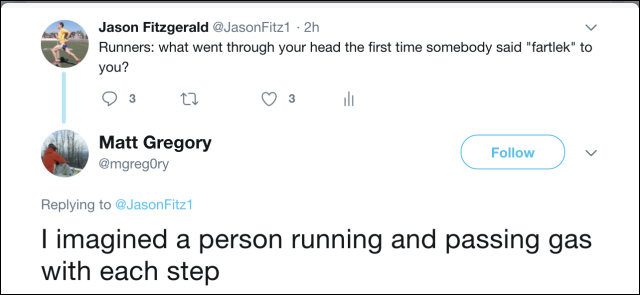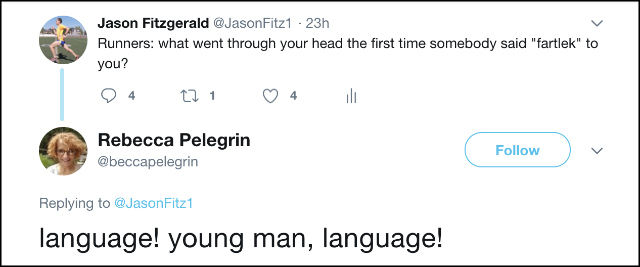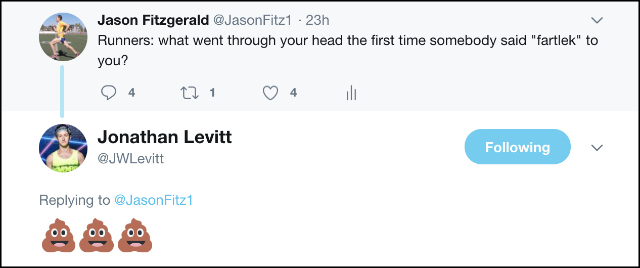Fartlek training is a versatile, powerful, and silly-sounding way to run fast workouts. And fartleks can be done by anybody – virtually anywhere.

An accurate depiction of fartlek training
In high school, I thought I was a “tough” runner. Racing fast requires one to endure suffering and I told myself that I was good at withstanding the strong discomfort of running fast.
That is, until one specific fartlek workout during cross country left me wondering if knitting was a more appropriate hobby.
My coach devised a devilish workout:
- We ran hard on the track, about 5k race pace, when he blew his whistle
- We slowed to a recovery jog when he blew the whistle again
- Rinse and repeat until coach decided that we had had enough
This is a variation of a fartlek workout. And what makes it so challenging is that we didn’t know when the repetition would end – that was up to the whims of our maniacal coach.
It as then that I realized that even though fartlek training sounded funny, these were serious workouts.
Benefits of Fartlek Training
With no mental model of how long we were running at race pace, our perceived effort was higher. The workout just felt so hard despite it not being that long or fast. It was more mental training rather than physical training – and made me rethink how tough I thought I was…
And there lies the beauty of fartlek training: it’s so incredibly versatile.
No matter the goal, fartleks can be incorporated in so many ways:
- Use fartlek training in place of more traditional, formal track workouts
- Vary the duration and pace to introduce randomness to develop higher levels of mental fitness
- Use fartleks as a “bridge” between easy running and more structured, challenging workouts
- Run a fartlek workout to have fun with no extra pressure!
In other words, they’re effective at accomplishing nearly any workout goal you might have! No wonder fartleks are so popular.
What exactly is Fartlek Training?

What the fartlek?!
Mention the word fartlek and non-runners will arch an eyebrow and ask slowly, “I’m sorry… say that one more time?”
Fartlek is a Swedish word that translates to “speed play” and can be simplified to mean alternating fast running with slower running.
That’s it! Now you understand what a fartlek workout entails: faster repetitions with slower recoveries.
According to Michael Sandrock’s Running Tough, fartlek training was popularized by two Swedish milers named Gunder Hägg and Arne Anderson. Two of the top milers in the world, they “knocked loudly on the door of the 4-minute mile in the 1940’s.”
Sandrock goes on to describe the visceral nature of fartlek training:
Fartleks can take us back beyond our childhoods, back to the primal origins of running, as I discovered on a trip to Kenya. When I was in the Rift Valley training with the young runners, we would sometimes run across pathless fields, the sun hanging low above the Rift Valley escarpment in the distance.
I remember thinking, This is how our ancestors must have run when they first stood up on two legs not so far from here.
Coach Brad Hudson describes the fartlek as a training tool in his book Coach Hudson’s Little Black Book:
A fartlek can be used to accomplish just about anything that you would want to get done on the track. There are a lot of ways to raise fitness and get in great workouts, and they don’t all have to happen under the structure of an oval.
Many times a fartlek can be used as a general workout, a light workout, or a “do-as-you-feel” workout. You can also turn it into a harder, more specific workout to be used at any point in training.
Structure of Fartlek Workouts
Because fartlek training is so versatile, you can structure workouts in nearly endless combinations:
- Fixed distance for the repetition
- Fixed time for the repetition
- Varying distance/time for the reps
- Varying pace for both the rep and the recovery interval
Usually, fartlek workouts are done on the road or trail. They’re not as structured as track workouts so they can literally be done anywhere that you can run. But you can also run them on the track, too.
2 Types of Fartlek Training Workouts

For more hilarity, see Jason on Twitter
Fartleks can be easy, general, specific, hard, or race-specific. With the inherent variety in fartlek training, there are virtually unlimited workouts that you can structure.
But there are two types of fartleks that are most common: time-based and random fartlek workouts.
Time-Based Fartlek
A time-based fartlek is probably the most popular because it’s most true to the spirit of the fartlek. Each repetition is based on time, rather than distance.
A few examples could include:
- 10 x 30 seconds hard, 1 minute recovery
- 1, 2, 4, 5, 4, 2, 1 minute pyramid fartlek at varying efforts
- (5 x 2 minutes) + (4 x 1 minute) at 5k / mile effort
The options available to you within this narrow type of fartlek workout are nearly endless.
Random Fartlek
A random fartlek is when the repetitions or the recovery is varied based on the terrain, your passing whims, or the song playing in your earbuds. In other words, the reps can be quite random!
A few examples could include:
- Run uphills hard, downhills easy on rolling terrain (great for building strength)
- Alternate a playlist with short and long songs and use those to influence your workout
- Run hard until you feel like slowing down. Run easy until you feel like speeding up. Repeat.
- Like my example from high school above, enlist a partner to determine the repetition length for you!
- Run hard to certain landmarks (signs, trees, mailboxes) and recover until the next landmark
These random fartleks are best used during base training when specific fitness isn’t the goal. They can be made easier than traditional workouts so they help transition the athlete between easy running and hard running.
If you want more specific fartlek workout examples, I recorded a quick video with my three favorites:
Fartlek training can be easy or hard (or somewhere in the middle) and these three workouts deliver!
Want more workout ideas? Check out my book, 52 Weeks, 52 Workouts, One Faster Runner.
Fartlek Training Q&A
It’s not every day that you need to recover from a giggle fit and then learn Swedish to figure out a running workout.
And I’m sure other questions have come up about fartlek training so let’s do some Q&A!
When is it ideal to run fartlek workouts?
Fartlek training sessions can be run anytime – since they can be used for virtually any training purpose.
Often, they’re used as a bridge between base training and specific training. This has less to do with the physical demands of the workout and more with the mental challenges.
Hudson explains in his Little Black Book:
There are times early in a training phase when an athlete may be phsyically prepared for a hard workout, but may not be mentally ready to take on a set of standard intervals and distances.
There can be a big difference, mentally, between doing 10 x 1,000m and 10 x 3 minutes.
Sometimes it is just as beneficial to do a hard workout by placing the emphasis on feel and effort rather than being tied to pace and distance.
There’s less pressure on the runner when they’re running for time and effort, rather than distance and pace.
Are fartleks better used for some races and not others?
I think so! Since fartlek workouts are rarely run on the track, they’re typically done on roads or when you’re out trail running.
Because these sessions are executed on these surfaces, they lend themselves to road or trail races. I also think fartleks are great for:
- Cross country (which are very similar to trail races)
- Ultramarathons (these are usually held on trails)
- Obstacle course races (like Warrior Dash)
Whenever you’re training for a race that can be hilly, off-road, or has a lot of stopping and starting, then fartlek workouts are an effective workout to build race-specific fitness.
What type of runner benefits from fartleks?
Any runner! Since fartleks are so incredibly versatile, they can be used by a brand new runner or the professional preparing for the Olympic Games.
But fartlek workouts can be particularly beneficial for new runners because there’s less pressure to perform. You don’t need to hit an exact pace during a fartlek – effort is more important.
And that’s exactly what new runners should be trying to learn: the ability to “feel” a given pace, making it intuitive and second-nature. If you can control your pace by relying on your perception of effort, you’ll be a more skilled runner.
Combine more traditional interval sessions on the track with fartlek workouts and runners will have a more nuanced, complete understanding of what various paces feel like.
And that makes racing a lot more productive!
What pace are fartlek workouts?
Fartlek training is much like children chasing each other in a big field: there’s no set pace or recovery. It’s all up to you.
You can run with the landscape, opening up on downhills and slowing down on the uphills (or vice versa). You can sprint through a field, run hard on the straight sections of a trail, and recover whenever you’d like.
Sprint, run easy, go hard or steady, and then run gently. It’s entirely up to you.
You can make fartleks more structured or less structured. Fartlek sessions that are more “formal” will have specific paces and recoveries – but not all of them.
Most importantly, enjoy yourself. Fartleks have an element of joy embedded within them that you simply don’t get from track workouts so enjoy some trail running and make sure you have fun!
If you’d like me to help you plan your workouts, consider one of our training programs. I’ll take the guesswork out of your training!